I Purchased our BugE on E-Bay Sept. 7, 2008
This BugE is a 2007 vintage kit (no rear suspension) originally built in 2008 by Ed Gunderson of Creswell, OR. It is a 36volt machine with a large, fast charger (20amp) taking the place normally used by the 4th battery.
Ed built his BugE as an open roofed, cool looking vehicle intending to use it to commute with his Surfboard to the Ocean. But, he soon found he was driving the BugE instead of his bicycle, so he decided to sell it to fund a HPV. Here's a picture of Ed driving our BugE in the 2008 Earth Day parade in Oregon with his surfboard on top.

In 2008, I had been struggling to design and build a fully stream-lined three wheeled, electric vehicle. I was stuck on the compromises required for the front steering and suspension (i.e. it must be strong but extremely light weight and aerodynamic). So, when Ed's BugE became available on E-bay, I was happy to get it. My intention is to benchmark it's performance and improve its aerodynamics during my daily commute to work 10 miles from home. Based on my experience with the BugE, Schultz Engineering may develop some BugE aftermarket products for BugE builders.
This is a picture of the BugE being crated at Tom Smith's Fiberglass in Eugene,
(notice Scott Smiths BugE in the background)...
BugE Arrived in Michigan Sept. 17, 2008 with a smashed shipping crate, but the BugE was fine!
Licensed and Insured for Michigan Sept. 18, 2008!
This process was painless because it was previously titled, licensed and insured as a motorcycle in Oregon.
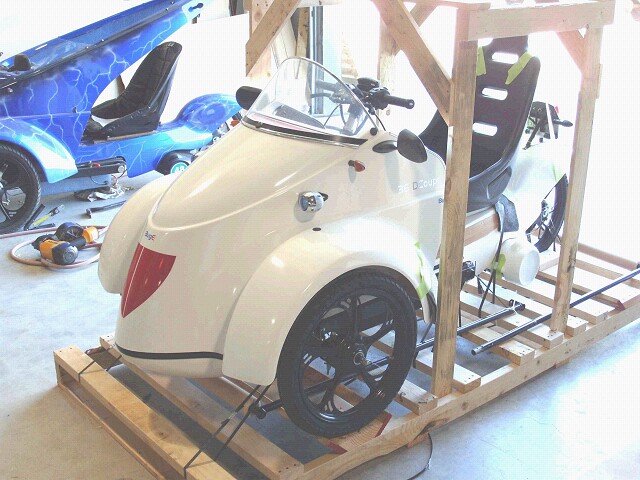
This BugE is a 2007 vintage kit (no rear suspension) originally built in 2008 by Ed Gunderson of Creswell, OR. It is a 36volt machine with a large, fast charger (20amp) taking the place normally used by the 4th battery.
Ed built his BugE as an open roofed, cool looking vehicle intending to use it to commute with his Surfboard to the Ocean. But, he soon found he was driving the BugE instead of his bicycle, so he decided to sell it to fund a HPV. Here's a picture of Ed driving our BugE in the 2008 Earth Day parade in Oregon with his surfboard on top.

In 2008, I had been struggling to design and build a fully stream-lined three wheeled, electric vehicle. I was stuck on the compromises required for the front steering and suspension (i.e. it must be strong but extremely light weight and aerodynamic). So, when Ed's BugE became available on E-bay, I was happy to get it. My intention is to benchmark it's performance and improve its aerodynamics during my daily commute to work 10 miles from home. Based on my experience with the BugE, Schultz Engineering may develop some BugE aftermarket products for BugE builders.
This is a picture of the BugE being crated at Tom Smith's Fiberglass in Eugene,
(notice Scott Smiths BugE in the background)...
BugE Arrived in Michigan Sept. 17, 2008 with a smashed shipping crate, but the BugE was fine!
Licensed and Insured for Michigan Sept. 18, 2008!
This process was painless because it was previously titled, licensed and insured as a motorcycle in Oregon.

The chopped BugE fits snuggly in a 1993 Grand Caravan
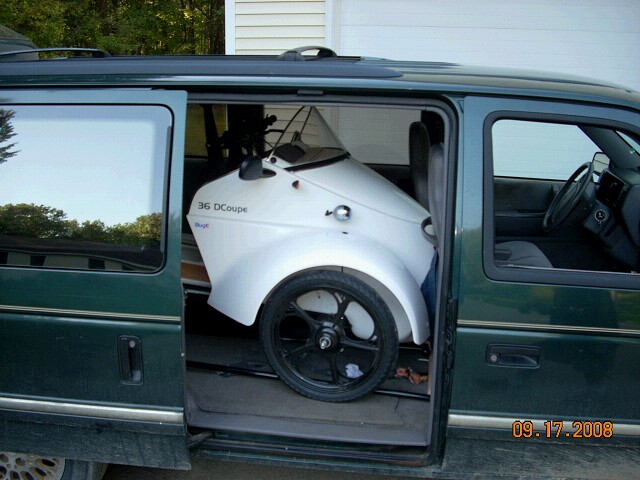
Due to the low ground clearance of the BugE, I made special ramps to get it into my minivan. First, after taking off the seat, I drive the BugE up the ramp until the front wheels are in (don't try this with out the throttle override circuit shown below). Then, the center ramp is lifted upright via cam action and locked into position with the safety chain. At this point, the BugE can roll into the van without getting hung up. Exit the van in the opposite order.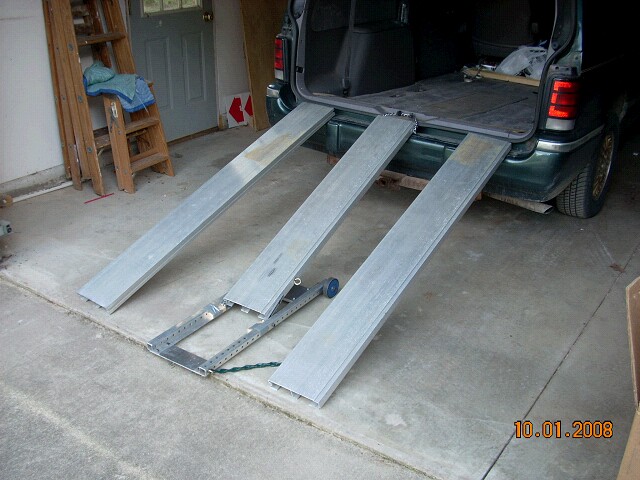
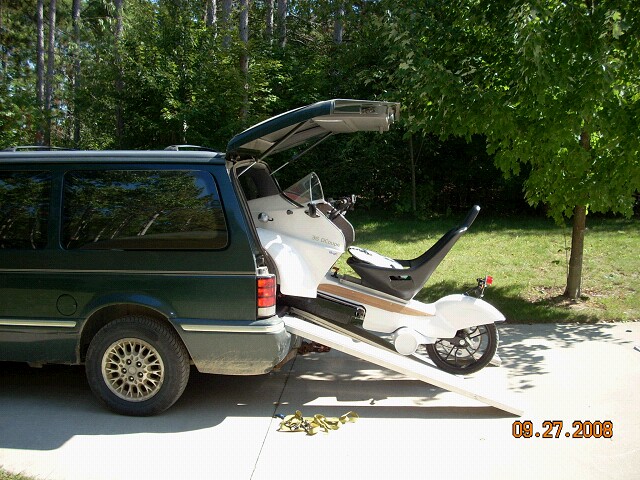
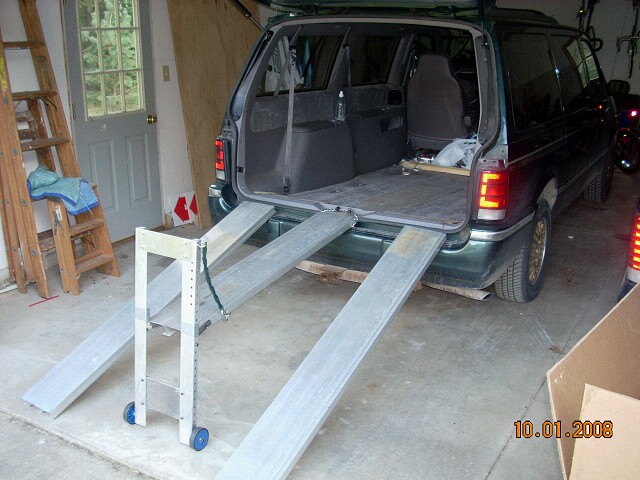

Due to the low ground clearance of the BugE, I made special ramps to get it into my minivan. First, after taking off the seat, I drive the BugE up the ramp until the front wheels are in (don't try this with out the throttle override circuit shown below). Then, the center ramp is lifted upright via cam action and locked into position with the safety chain. At this point, the BugE can roll into the van without getting hung up. Exit the van in the opposite order.



Public response is awesome!
The BugE has great curb appeal. It looks much better in person than in pictures. The fiberglass body has a beautiful gel coat / shine and an extremely unique look (and sound...the electric motor makes quite a whine) on the road. My brother and I went out for a test drive. He was driving the BugE and I was on my Electric Motorcycle. Off the line, I could not keep up with him, as the BugE has some really nice gearing and is very quick off the line. We went up and down a street in a sub-division a few times and people starting lining the road! One person even ran into the house returning with a camera to take pictures! Its reminiscent of 100 years ago when people (and entire towns) saw their first car.
This is one of my personal goals in developing light-weight, super aerodynamic transportation vehicles: to help people learn that there are practical alternatives to the 20th century automobile paradigm.

The BugE has great curb appeal. It looks much better in person than in pictures. The fiberglass body has a beautiful gel coat / shine and an extremely unique look (and sound...the electric motor makes quite a whine) on the road. My brother and I went out for a test drive. He was driving the BugE and I was on my Electric Motorcycle. Off the line, I could not keep up with him, as the BugE has some really nice gearing and is very quick off the line. We went up and down a street in a sub-division a few times and people starting lining the road! One person even ran into the house returning with a camera to take pictures! Its reminiscent of 100 years ago when people (and entire towns) saw their first car.
This is one of my personal goals in developing light-weight, super aerodynamic transportation vehicles: to help people learn that there are practical alternatives to the 20th century automobile paradigm.

Dash Board 9-25-08
In preparation to doing some benchmarking on energy usage per mile, (and to make it safe for my kids to drive and make it possible for me to load it into my mini-van by myself), I added a dashboard with some throttle over-ride controls. The dashboard is made out of black, textured ABS sheet plastic (3/16 thick). The bottom edge has a 48 inch radius.
On the dashboard, I installed a on/off switch (that triggers the high power selonoid), a turbo/tame switch, a throttle response potentiometer and a temporary Voltage meter.
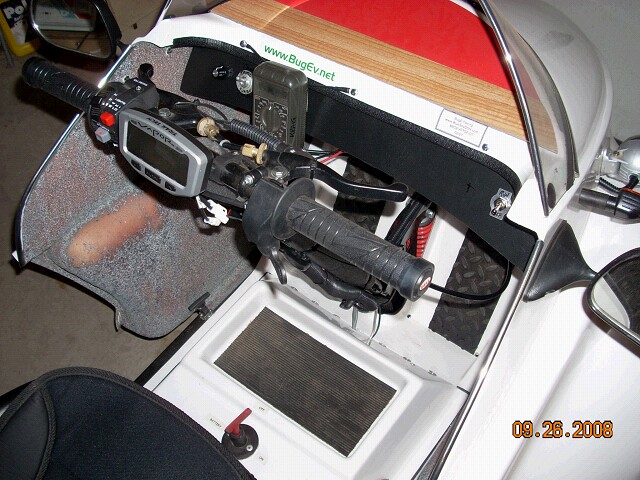
In preparation to doing some benchmarking on energy usage per mile, (and to make it safe for my kids to drive and make it possible for me to load it into my mini-van by myself), I added a dashboard with some throttle over-ride controls. The dashboard is made out of black, textured ABS sheet plastic (3/16 thick). The bottom edge has a 48 inch radius.
On the dashboard, I installed a on/off switch (that triggers the high power selonoid), a turbo/tame switch, a throttle response potentiometer and a temporary Voltage meter.

Wiring For Throttle Response Control 9-25-08
In TURBO mode, the throttle works normally.
In TAME mode, the 0-10K potentiometer is wired in parallel with the 0-5K throttle giving the ability to infinitely override the maximum throttle from 0-3333 Ohms.
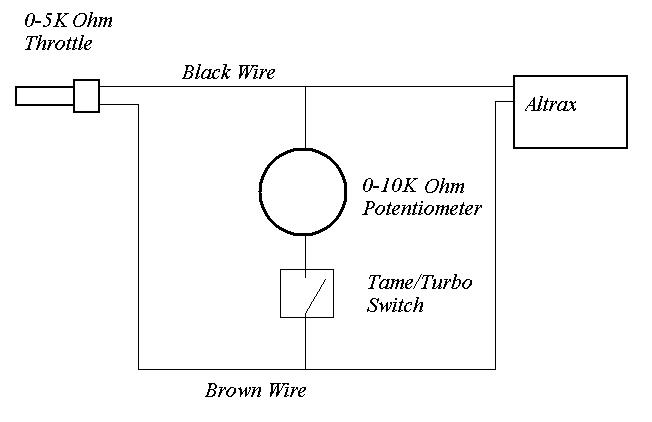
In TURBO mode, the throttle works normally.
In TAME mode, the 0-10K potentiometer is wired in parallel with the 0-5K throttle giving the ability to infinitely override the maximum throttle from 0-3333 Ohms.

Energy Usage Sept. 28, 2008
Range to 1/2 Depth of Discharge (36 Volts) is about 14 miles at 28-30 miles/hour velocity.
Recharge time to 90% is less than 2 hours.
Energy to recharge per Kill-A-WATT P3 energy meter
Watts Per Mile = 69
Electricity Cost Per Mile (at $.10/kWh) = $.0068
(Less than 1 penny per mile)
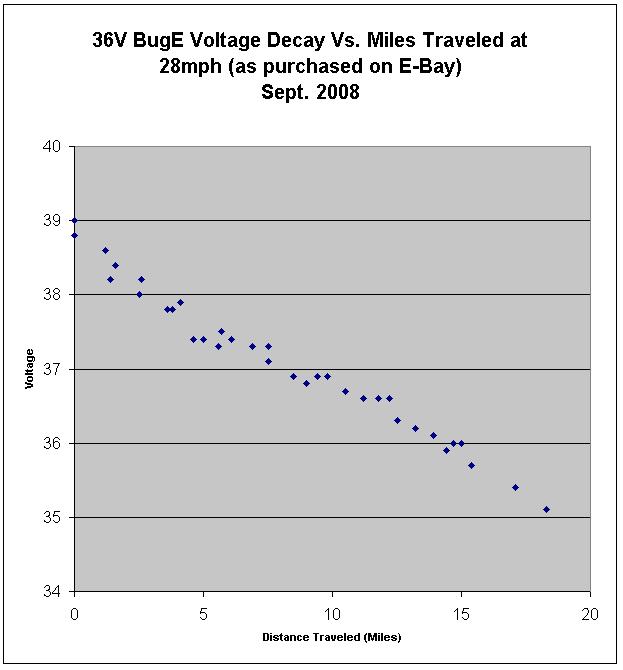
Range to 1/2 Depth of Discharge (36 Volts) is about 14 miles at 28-30 miles/hour velocity.
Recharge time to 90% is less than 2 hours.
Energy to recharge per Kill-A-WATT P3 energy meter
Watts Per Mile = 69
Electricity Cost Per Mile (at $.10/kWh) = $.0068
(Less than 1 penny per mile)
